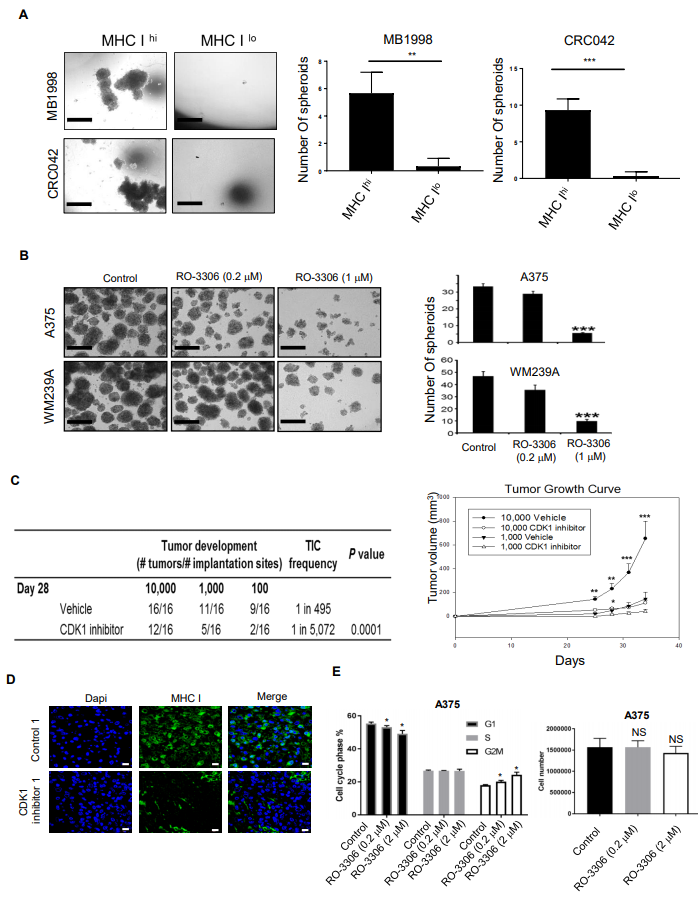CDK1 is a normal protein that drives cells through the replication cycle, while MHC class 1 molecule is also a normal molecule that exhibits a small amount of protein on the cell surface for examination by the immune system; Recently, scientists from the University of Colorado Cancer Center found that a group of cancer cells labeled with MHC class 1 molecule and high levels of CDK1 are extremely unusual. In fact, high levels of MHC class 1 molecule and CDK1 are often the key to the development of certain diseases, such as melanoma, pancreatic cancer, and colon cancer. In fact, these cells may be cancer stem cells that scientists have long sought. Once the cancer patient’s treatment is finished, these cells become resistant to chemotherapy and re-sown the seeds of cancer.
Often, cancer researchers will develop tumors and then look for drugs or genetic changes that will promote tumor growth or atrophy. However, in current research, researchers don’t want to change the size of the tumor, but to find out which factors are the first that will promote the growth of tumors. To answer this question, the researchers used patient samples, mouse models, and public genetic data to investigate the genetic commonality of cells that could trigger melanoma, pancreatic cancer, and colon cancer.

First, the researchers studied MHC class 1 molecule, which is located on the surface of human cells and function like a waving flag. When the molecule waved a flag (actually showing a small amount of protein), the immune cells would consider the cells as a foreign object and attacked it. For this reason, many cancer cells will down-regulate MHC to successfully evade the host’s immune system. In the research, the researchers found that a class of cancer cells that can initiate the formation of new tumors does not down-regulate MHC class 1 molecule.
According to Mayumi Fujita, MD, these cancer cells may have another route to evade the body’s immune system. Cancer cells that retain MHC class 1 molecules also retain the characteristics of healthy cells. That is, with the CDK1 molecule, the cells can progress through the replication cycle, and the process cannot be completed without the CDK1 molecule, and the more CDK1 molecules, the faster the melanoma cells turn on the formation of new tumors.
The researchers also wondered why CDK1 molecules can not only control the cell cycle, but also control the stem-ness of cells. Later, the researchers found that Sox2 is a special transcription that helps embryonic stem cells and neural stem cells maintain their stem-ness. It is also a marker of cancer stem cells that is associated with 25 different forms of diseases. Although Sox2 is considered a cancer driver, researchers still consider this molecule to be a very difficult target. It is difficult for researchers to control transcription factors such as Sox2. Sox2 is very important for tumorigenesis, but it is difficult to find a Sox2 inhibitor. In this study, researchers found that CDK1 can directly interact with Sox2 to maintain the characteristics of cancer cells. If CDK1 is able to control the function of Sox2 through interaction, researchers may be able to inhibit Sox2 function by targeting CDK1 or interfering with CDK1-Sox2 interactions.
More importantly, the properties of MHC class 1 molecule, CDK1 and Sox2 are very common in melanoma, colon and pancreatic cancer, suggesting that cancer stem cells in many types of cancer may share common characteristics. Finally, researcher Fujita said that we can’t say that all tumor types have such characteristics, but this feature is at least very popular, and this phenotype is very common in melanoma, pancreatic cancer, and colon cancer. In the next step, the researchers hope to clarify the mechanism of Sox2 regulation mediated by CDK1 through more in-depth research, and they hope to find new targets to effectively block the activity of Sox2.
Reference
Dinoop Ravindran Menon, Yuchun Luo, John J. Arcaroli, et al. CDK1 interacts with Sox2 and promotes tumor initiation in human melanoma, Cancer Research (2018). DOI: 10.1158/0008-5472.CAN-18-0330